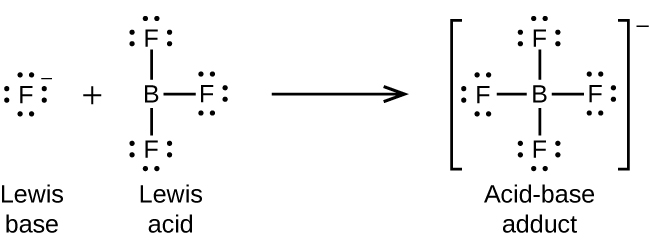15.2 Lewis Acids and Bases
Learning Objectives
By the end of this section, you will be able to:
- Explain the Lewis model of acid-base chemistry
In 1923, G. N. Lewis proposed a generalized definition of acid-base behavior in which acids and bases are identified by their ability to accept or to donate a pair of electrons and form a coordinate covalent bond.
A coordinate covalent bond (or dative bond) occurs when one of the atoms in the bond provides both bonding electrons. For example, a coordinate covalent bond occurs when a water molecule combines with a hydrogen ion to form a hydronium ion. A coordinate covalent bond also results when an ammonia molecule combines with a hydrogen ion to form an ammonium ion. Both of these equations are shown here.

Reactions involving the formation of coordinate covalent bonds are classified as Lewis acid-base chemistry. The species donating the electron pair that compose the bond is a Lewis base, the species accepting the electron pair is a Lewis acid, and the product of the reaction is a Lewis acid-base adduct. As the two examples above illustrate, Brønsted-Lowry acid-base reactions represent a subcategory of Lewis acid reactions, specifically, those in which the acid species is H+. A few examples involving other Lewis acids and bases are described below.
The boron atom in boron trifluoride, BF3, has only six electrons in its valence shell. Being short of the preferred octet, BF3 is a very good Lewis acid and reacts with many Lewis bases; a fluoride ion is the Lewis base in this reaction, donating one of its lone pairs:

In the following reaction, each of two ammonia molecules, Lewis bases, donates a pair of electrons to a silver ion, the Lewis acid:

Nonmetal oxides act as Lewis acids and react with oxide ions, Lewis bases, to form oxyanions:

Another type of Lewis acid-base chemistry involves the formation of a complex ion (or a coordination complex) comprising a central atom, typically a transition metal cation, surrounded by ions or molecules called ligands. These ligands can be neutral molecules like H2O or NH3, or ions such as CN– or OH–. Often, the ligands act as Lewis bases, donating a pair of electrons to the central atom. These types of Lewis acid-base reactions are examples of a broad subdiscipline called coordination chemistry.
Key Concepts and Summary
A Lewis acid is a species that can accept an electron pair, whereas a Lewis base has an electron pair available for donation to a Lewis acid. Complex ions are examples of Lewis acid-base adducts and comprise central metal atoms or ions acting as Lewis acids bonded to molecules or ions called ligands that act as Lewis bases.
Glossary
- complex ion
- ion consisting of a central atom surrounding molecules or ions called ligands via coordinate covalent bonds
- coordinate covalent bond
- (also, dative bond) covalent bond in which both electrons originated from the same atom
- Lewis acid
- any species that can accept a pair of electrons and form a coordinate covalent bond
- Lewis acid-base adduct
- compound or ion that contains a coordinate covalent bond between a Lewis acid and a Lewis base
- Lewis acid-base chemistry
- reactions involving the formation of coordinate covalent bonds
- Lewis base
- any species that can donate a pair of electrons and form a coordinate covalent bond
- ligand
- molecule or ion acting as a Lewis base in complex ion formation; bonds to the central atom of the complex

